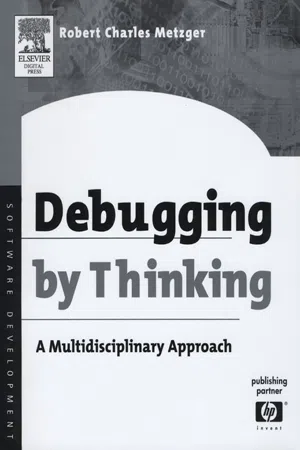
- 600 pages
- English
- ePUB (mobile friendly)
- Available on iOS & Android
About this book
Debugging by Thinking: A Multi-Disciplinary Approach is the first book to apply the wisdom of six disciplines—logic, mathematics, psychology, safety analysis, computer science, and engineering—to the problem of debugging. It uses the methods of literary detectives such as Sherlock Holmes, the techniques of mathematical problem solving, the results of research into the cognitive psychology of human error, the root cause analyses of safety experts, the compiler analyses of computer science, and the processes of modern engineering to define a systematic approach to identifying and correcting software errors.* Language Independent Methods: Examples are given in Java and C++* Complete source code shows actual bugs, rather than contrived examples* Examples are accessible with no more knowledge than a course in Data Structures and Algorithms requires * A "thought process diary" shows how the author actually resolved the problems as they occurred
Frequently asked questions
- Essential is ideal for learners and professionals who enjoy exploring a wide range of subjects. Access the Essential Library with 800,000+ trusted titles and best-sellers across business, personal growth, and the humanities. Includes unlimited reading time and Standard Read Aloud voice.
- Complete: Perfect for advanced learners and researchers needing full, unrestricted access. Unlock 1.4M+ books across hundreds of subjects, including academic and specialized titles. The Complete Plan also includes advanced features like Premium Read Aloud and Research Assistant.
Please note we cannot support devices running on iOS 13 and Android 7 or earlier. Learn more about using the app.
Information
Introduction
1.1 The nature of the problem
1.1.1 Definitions
1.2 The six ways of thinking




Table of contents
- Cover image
- Title page
- Table of Contents
- Copyright
- Dedication
- Preface
- Chapter 1: Introduction
- Chapter 2: Sherlock Holmes
- Chapter 3: Lord Peter Wimsey
- Chapter 4: Professor Solomon
- Chapter 5: Case Studies I
- Chapter 6: Mathematical Problem Solving
- Chapter 7: Debugging Strategies
- Chapter 8: Debugging Heuristics
- Chapter 9: Debugging Tactics
- Chapter 10: Case Studies II
- Chapter 11: The Way of the Safety Expert
- Chapter 12: The Way of the Psychologist
- Chapter 13: The Way of the Engineer
- Chapter 14: The Way of the Computer Scientist
- Chapter 15: Get Back to Work
- Glossary
- Root-Cause Checklist
- Books about Debugging
- Software Recommendations
- References
- INDEX